Jan 14, 2022 | obituary
 The numismatic community lost a bright young star with the announcement that Muriel Eymery died this week. Eymery served as an ANA Governor from 2019-2021.
The numismatic community lost a bright young star with the announcement that Muriel Eymery died this week. Eymery served as an ANA Governor from 2019-2021.
Eymery advocated expanding numismatics worldwide as a member of the Board of Governors and in her career. Eymery worked for Spink and Sons and was Vice President of International Business Development at PCGS. She also worked for the French Mint that taught her the global market dynamics.
While considering running for the Board of Governors in 2021, I spoke with Eymery about our shared ideas about the hobby. We found a common interest in expanding numismatics beyond the basics to include the world community and other collectibles. Eymery was a bright light in the future of the numismatic community.
Stan Chu of Boston Rare Coins and Collectibles wrote on Facebook that Eymery’s sister Carol said that Muriel had battled lung cancer for the last six months. She “passed away peacefully and painlessly in her [sister’s] arms.”
As a memorial to Muriel Eymery, I will make made a donation in her memory to the ANA. Please consider doing the same.
Jan 5, 2022 | obituary
The following was sent to customers of Stack’s-Bowers announcing the passing of Harvey Stack.
My thoughts will be below the announcement.
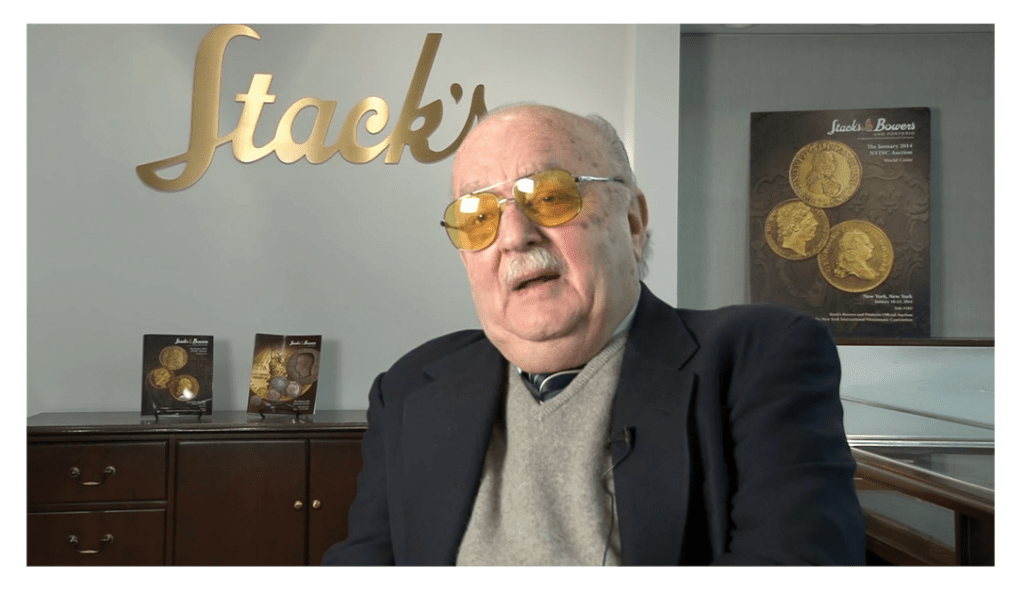
It is with great sadness we announce the passing of our friend and founder, Harvey G. Stack on January 3, 2022. His leadership over the years spearheaded our operations and his kindness and mentorship to staff, collectors, dealers, numismatic organizations and colleagues will never be forgotten.
Harvey was born in Manhattan on June 3, 1928, the son of Morton M. Stack and Muriel Stack. He grew up in Bronx and Jamaica, New York and attended NYU. His life revolved around his family and around numismatics, as generations of the Stack family built upon the rare coin business founded in 1933 by Harvey’s father, Morton, and his uncle Joseph at 690 Sixth Avenue in Manhattan. Presenting their first public auction in 1935, Stack’s quickly progressed to larger premises and a growing reputation. Although as a youngster Harvey worked after school and during vacations at the firm’s Manhattan coin store, it wasn’t until 1947 that he went to work full time for Stack’s Rare Coins, a career that would last more than 70 years. As one of the second generation of family members to join the firm, Harvey worked alongside his father, uncle, and cousins Norman and Benjamin, supported by a staff of experts that comprised many of the most well-known professional numismatists of the 20th century.
In 1953 Stack’s moved to a gallery at 123 West 57th Street, a location that would be home to the firm for more than 60 years and become a popular destination, known as the “clubhouse” for collectors from all over the world. As a family member, Harvey’s responsibilities were wide ranging, assisting clients in the store, traveling to pick up collections and attend conventions and coin shows, cataloging auction lots, auctioneering, and any other work that needed to be done. He became an expert in many areas of numismatics and was able to translate his warm and jovial personality into long-term relationships with the collectors and dealers he worked with over his career.
The decades following World War II were times of great growth for Stack’s. Besides opening a new and improved location, they were tapped to present at auction many important collections including Anderson-Dupont, Davis-Graves, Charles A. Cass (“Empire”), R.L. Miles, Massachusetts Historical Society, Samuel Wolfson, and George Walton, as well as conducting public auctions in conjunction with major numismatic shows including the American Numismatic Association and the Metropolitan New York conventions. In the 1970s, Harvey’s son Larry and daughter Susan joined the firm, bringing in a third generation.
Harvey and the Stack family were instrumental in building some of the greatest collections of their time, including the cabinet of gold coins assembled by Josiah K. Lilly, chairman of the Eli Lilly & Co. pharmaceutical company. After Lilly’s death in 1966, his collection of over 6,000 coins became part of the National Numismatic Collection at the Smithsonian, a process aided by Harvey and other members of the Stack family. Over the decades, Harvey and the Stack family also built a relationship with Louis E. Eliasberg, Sr., who accumulated the only complete collection of United States coins ever formed. In 1976, when the nation was celebrating its Bicentennial, Harvey and the firm helped facilitate the display of Eliasberg’s incomparable collection at the United States Mint in Philadelphia.
Harvey Stack’s role in numismatics was not purely business. He fought for clearer import regulations on coins from overseas and testified before a congressional subcommittee leading up to the Hobby Protection Act of 1973. He worked with the American Numismatic Association and other professionals in the effort to develop a standardized grading system for coins. In 1996 he appeared before the U.S. House Banking Committee to propose the 50 State Quarters Program, which brought countless new collectors into the hobby. Harvey Stack served on the board of the Professional Numismatists Guild for nearly a decade and acted as its president for two years beginning in 1989. In 1993 he received the PNG’s Founder’s Award, their highest honor, for his dedication to the hobby. Over the years, Harvey was a great supporter of the American Numismatic Association, the American Numismatic Society, and the Smithsonian Institution. He was a long-term member of the International Association of Professional Numismatists, as well as numerous other numismatic societies.
As the 20th century turned to the 21st, Harvey Stack and Stack’s were still going strong, as Larry and Harvey brought to auction the incredible John J. Ford, Jr. Collection, and many other famous name cabinets. In addition, they partnered with Sotheby’s in the record-breaking sale of the first 1933 Saint-Gaudens double eagle to cross the auction block. In 2011, Stack’s merged with Bowers and Merena to create Stack’s Bowers Galleries, one of the top numismatic auction firms in the country and a company that continues the Stack family’s legacy of presenting important numismatic cabinets and realizing record-breaking prices. Harvey remained involved in the new business until the very end, telling the company’s history, mentoring staff members, and maintaining his relationships within the hobby. Most recently he and Larry worked with the estate of long-time friends and clients Mark and Lottie Salton to bring their outstanding collection of world and ancient coins to market. It is unfortunate that Harvey will not be there to see the fruits of his labor as this remarkable cabinet crosses the auction block in 2022 and 2023.
Harvey was predeceased by his parents, his uncle Joseph, his cousins Norman and Ben. He is survived by his wife, Harriet, children Larry (Loretta) and Susan (Larry), grandchildren Rebecca (Jimmy) and Matthew (Tanya), and five great-grandchildren: Bryce, Avery, Dylan, Brielle and James.
Services will be private. In lieu of flowers, donations can be made to the Leukemia & Lymphoma Society, the American Numismatic Society or a charity of choice.
Personal Remembrance
I met Harvey Stack for the first time in 1971 at their 57th Street store in Manhattan. There was no formal “take your child to work” program in those days. My father would take me into the city with him one day a year, and they would give me busy work to do when I was not doing my homework. But the fun was around lunchtime.
After grabbing a sandwich, we would walk over to Stack’s to look at the coins and buy a few. It did not matter if you were coming with your father, an experienced collector, or even if you were a change picker. Everyone was welcome at Stack’s.
The first time I visited the store, there was a lot of activity. A lot of people were talking about and looking at coins. I remember that Harvey Stack was presiding over the gaggle. When he saw my father and me, he came over to help us. Aside from helping me pick out two Roosevelt Dimes for my collection, he taught me what to look for in a good dime. It was the first time I saw a Buffalo nickel.
We left that day with the dimes, a few Buffalo nickels, a Whitman Classic Album for the nickels, and a new Red Book. It was more than my father wanted to pay, but he knew it would keep me occupied all afternoon.
We lived in New York for two more years before moving. I continued to visit Stack’s when I was in the area. The store always had a lot of activity, but Harvey Stack had slowed down in the last few years.
Stack’s was the first dealer I visited, and I will never forget Harvey Stack for helping me get started.
Dec 26, 2018 | obituary, personal
This post does not contain any numismatic content.

The day Boomer fell into our hearts: December 2, 2006.
Boomer was far more intelligent than he originally let on. As many puppies do, he explored his limits he began to not only understand what he could or could not do, but how to pull at his new mommy and daddy’s heartstrings.
A cross between a pug and a beagle, Boomer showed more of the personality of the beagle but had the snuggle ability of the pug. Boomer was a snuggler, always wanting to sit on the couch or crawl into bed to snuggle with us.
Like the beagle, Boomer could bark and howl with the best of them. He was our storm warning system. When the thunderstorms were off in the distance, Boomer would warn us and howl right through the storm. We nicknamed him Thunder Boomer.
When we brought home Tessa, he was tolerant of her mishegas. She was much more active than the laid back Boomer but I think they grew to like each other. Tessa was really attached to her brother.

This is our last picture of Boomer taken the morning of December 24, 2018. Good bye sweet prince!
Of all things, Boomer was a kind, sensitive, and loving dog who loved to be around us always wanted to snuggle and loved the attention. Since my wife and I could not have children, Boomer was our son.
At 5:25 am on December 25, our baby Boomer left us for his next adventure. He was a beautiful and smart boy. Always loved and always loving. Goodbye to our sweet prince.
Nov 16, 2017 | obituary

Eric P. Newman honored on his 100th Birthday
The following is the obituary scheduled to appear in the St. Louis Post-Dispatch.
ERIC PFEIFFER NEWMAN died Wednesday, November 15, 2017, at his home in Clayton at the age of 106. Devoted husband of the late Evelyn Edison Newman for 75 years, brother of the late Ivy Steele of Chicago, beloved father of Linda Newman Schapiro of New York and Andrew (Peggy) Newman of St. Louis, enthusiastic and inspiring “Opa” to his many grandchildren and great-grandchildren. A life-long resident of Clayton, Eric attended John Burroughs School from the day the school opened in 1923 and obtained his engineering degree from MIT and his law degree from Washington University.
Eric was a great lawyer, inventor, and historian, but he was best known as a numismatic collector and scholar, generous philanthropist, and inveterate traveler. He was a member of The Explorer’s Club and, with Evelyn, pioneered travel to every corner of the globe. Over the years, they enjoyed hosting family and friends both in St. Louis and at their homes in Jamaica, Martha’s Vineyard, and the bluffs of Alton, Illinois. Eric established the Newman Money Museum in St. Louis and authored over 100 books and articles, principally in the field of numismatics.
Both directly and through his role in the Eric P. & Evelyn E. Newman Foundation, the Eric P. Newman Numismatic Education Society, the Harry Edison Foundation, and the Edison Family Foundation, he helped in the creation of St. Louis institutions such as the Butterfly House, The Magic House, the Eric P. Newman Education Center at Washington University, and many of the concepts and events dreamed up by his wife Evelyn. Their marriage was an enduring and remarkable model of love, partnership, effectiveness, and concern for others.
The family wants to express its heartfelt thanks to Eric’s many compassionate caregivers. Per Eric’s wishes, there will be no funeral or memorial service. Any gift to your favorite charity would be a welcome tribute to his life. Messages of sympathy may be sent to EricNewmanFamily@gmail.com.
Special thanks to Wayne Homren, Editor of
The E-Sylum, for the text of the obituary.
Dec 9, 2016 | history, news, obituary
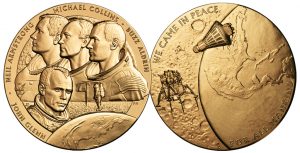
New Frontier Bronze Medal features the portraits of Apollo 11 astronauts Neil A. Armstrong, Michael Collins, and Edwin E. “Buzz” Aldrin Jr. facing left, and Friendship 7 astronaut John Herschel Glenn Jr. facing right. The reverse features the Apollo 11 LEM orbiting the moon and the Friendship 7 mission capsule orbiting Earth.
Heroism is climbing to the top of the Atlas LV-3B rocket, that was rushed to completion and whose tests did not exactly go as planned and launched into low Earth orbit trying to help the United States catch up in the space race. With the entire world watching and the next year after the Soviets made their own flight into orbit, John Herschel Glenn, Jr. rode Friendship 7 into history.

COL John Glenn
Glenn was so humble that he said that he was the just the next one up. But subsequent stories came out later that with the push to have an American fly in Earth’s orbit quickly, the schedule was manipulated so that Glenn was the pilot of that mission. Some have accused Glenn of using his relationship with President Kennedy for that honor, but that was later disproven.
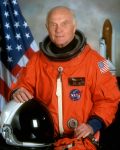
NASA Payload Specialist for STS-95
In between flights into space, Glenn became a corporate executive with Royal Crown Cola with an eye on politics. He started with an attempted run at the senate in 1964 but withdrew after a personal accident. He was with Robert F. Kennedy on the campaign trail when Kennedy was assassinated. In 1970 lost the Democratic primary for the senate against Howard Metzenbaum. Glenn finally won the 1974 Democratic primary and was elected Senator from Ohio, a seat he held until retiring in 1999.
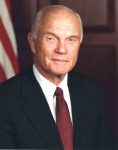
Official U.S. Senate portrait of John Glenn
From the day he dropped out of college to join the Army through the end, John Glenn has been nothing less than a hero. He spent most of this life in service to his country with impeccable honor and distinction. Glenn showed how good people can serve for the sake of service without having to get anything more out of the service than the satisfaction that he made life better.
We are better for having had John Herschel Glenn, Jr. amongst us.
Godspeed, John Glenn.

Still frame of John Glenn in orbit, taken by a motion picture camera inside Friendship 7
Credits
- Image of the New Frontier Bronze Medal courtesy of the U.S. Mint.
- All other images are from government sources and in the public domain.
Jun 28, 2016 | news, obituary
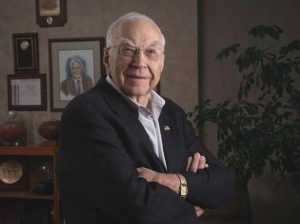 The numismatic world lost one of its great pioneers when Chester Lee “Chet” Krause passed away on June 25, 2016 from congestive heart failure. Chet was 92.
The numismatic world lost one of its great pioneers when Chester Lee “Chet” Krause passed away on June 25, 2016 from congestive heart failure. Chet was 92.
There are many tributes to Chet that will discuss his life and accomplishments you can read here, here, here, and this tribute by the current editor of Numismatic News Dave Harper.
I cannot say that I was Chet’s personal friend, but when you were around him he treated you like you were his best friend. The few times we met, he was a gentleman and generous with his time and knowledge. He was willing to talk numismatics as long as he could.
And he insisted that everyone call him Chet.
When I met him for the first time at the 2007 World’s Fair of Money where he became a member of the ANA Board of Governors, I said, “It is a sincere pleasure to meet you, Mr. Krause.” He chuckled as he said to call him Chet. I had a feeling that this was a theme throughout his life.
Chet published the first Numismatic News in 1952 in order to communicate with other coin collectors especially those living in rural areas. Later, he would work with Cliff Mishler to compile the Standard Catalog of World Coins, probably the most significant resource for collectors of world coins. Krause-Mishler (KM) numbers are a standard catalog identification system used by many collectors.
Chet was not just a numismatic publisher. Krause Publications published Old Cars, a weekly magazine for people with interest in classic and antique cars. Krause publications also publishes books and magazines about antiques, crafts, comics, outdoors, and other personal interests. While some see the Standard Catalog of World Coins is seen as a seminal work in the numismatic industry, Warman’s Antiques & Collectibles is a seminal work for those of us in that industry.
Regardless of his success, he was just Chet, an icon but you would never know it if you met him.
On behalf of the world you touched, from numismatics to collectibles, thank you Chet for helping make collecting that much more enjoyable.
Image courtesy of Numismatic News.
Feb 1, 2013 | exonumia, medals, news, obituary, tokens
My hometown was in the news today for two very different reasons, yet both remind me of why I continue to love New York.
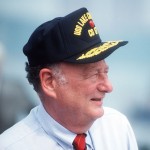
Mayor Ed Koch at the commissioning ceremony for the USS LAKE CHAMPLAIN (CG 57), 1988
Koch’s exuberance and love of New York propelled himself and the city from the what was seen as the bottom to a trajectory that you could not think of New York without Ed Koch or Ed Koch without New York. Koch’s perpetual question, “How am I doing?” will forever be his trademark throughout the streets, cabs, subways, highways, and byways of New York City.
A more happier note, it was on February 1, 1913 that Grand Central Station (really named “Grand Central Terminal” but that’s not what we called it growing up in New York) opened. It was not the first terminal on the site to bear the Grand Central name. The previous version opened in 1903 and comprised of three separate buildings. Over the next ten years the structure that stands there today was built in phases that including the underground rail tunnels that are still in use today.
Grand Central underwent a rehabilitation that started in 1994 through 2000 that cleaned up the famous ceiling in the grand concourse and reconfigured the above ground areas to include more shops. But it still represents the major transportation hub of New York.
Collecting transportation tokens are the ultimate numismatic collection that represents local history. Transportation has been at the heart of every city and can be used as a personal tie to your collectible. Tokens and medals representing local transportation can be more beautiful and significant than coins from the same era. Not long ago, I was able to find a pewter medal from the dedication of the East River Bridge. The bridge was rename in 1915 and is known today as the Brooklyn Bridge.
Having a collection of subway tokens reminds me of all those subway trips I had taken over the course of my life and the sesquicentennial medal of the Long Island Railroad represents my daily commutes from Long Island to my job at 30 Rock.
As I think about my hometown today, remember where you are from and consider starting a collection of tokens and medals that helps to tell your story. It can be as rewarding as your memories.
And to Hizzoner, you did just fine! Rest in peace.
Image of Ed Koch courtesy of Wikipedia.
Oct 6, 2011 | obituary
 Last night saw the passing of Steve Jobs, a computer industry pioneer who revolutionized more than the computing industry. Jobs revolutionized how technology influences our lives and culture. That technology has even had an effect on this blog.
Last night saw the passing of Steve Jobs, a computer industry pioneer who revolutionized more than the computing industry. Jobs revolutionized how technology influences our lives and culture. That technology has even had an effect on this blog.
I bought my first Mac in 2002. I had heard about the new Mac operating system MacOS X and I wanted to learn more, so I decided to find a used Mac to play with. At the time, my company was holding a surplus auction where they would auction computers and peripherals that were beyond their life cycle. That year, the company decided that they would standardize on Windows and those with Macs would have to give up their machines. I bid on a PowerBook G3 that was code named “Wall Street” and won. I bought a copy of MacOS X Jaguar (10.2), more memory and started learning the Mac.
This was the time of the “switcher” commercials. One commercial was a woman who talked about how she was able to recover pictures from her digital camera to save Christmas. It was not Christmas time, but I was sitting with a cheap digital camera I bought to try out digital photography and having a difficult time getting the drivers loaded under Windows 2000 (remember, this was in 2002). I opened the PowerBook to try that computer. I plugged in the camera and was searching for the camera’s instructions when I noticed that not only did iPhoto start, but recognized the camera and asked if I wanted to import the photos.
To say I was blown away would be an understatement. It was easy and ordering prints online from Apple were easy and not expensive. I was hooked. I transitioned everything from the Windows machine to the Mac and never looked back. Today, I am using my third Mac. I write and manage this blog using a 27-inch iMac (late 2009). Sweet machine!
That ease of use runs through Apple’s product line and was Steve Jobs’s vision. Digital music players existed before the iPod, but Jobs lead his team to do better. From the iPod to the online digital music store, iTunes, Jobs and Apple revolutionized the electronic music business like nobody has. This portable player also lead to the revolution that are podcasts that expanded our access to information. As I look down on my desk, there is my 6th generation iPod Nano that I will clip to my shirt to listen to podcast on the go.
There were smart phones before the iPhone, but after Jobs rejected two prototypes, he gave his most exciting keynote address (called a “Stevenote”) where he introduced a single device to surf the web, listen to music, and a cellular phone—no stylus required. Then, Apple adapted the concept of programming the phone (other than by web pages) and the app store was born. In the app store, we find a number of apps that have been reviewed here including The Numismatist reading app.
The last coin show I went to, I saw a few dealers taking payments with their iPhone. Using a device called Square attached to the earphone port, dealers could swipe credit cards and get approved for payments via their iPhone. With low swipe fees (2.75% per swipe), dealers can now accept credit cards and expand their business. This would not be possible without the technology behind the iPhone.
Yes, I will pre-order an iPhone 4S tomorrow.
Never satisfied to stand still, Jobs pushed his team to build the iPad. Rather than accept what was “normal” for tablet computers, Jobs took the lessons learned from the iPhone and created another drool-worthy device that others are trying to imitate. I drooled over the iPad for over a year until the iPad 2 came out—I never buy the first version of anything. It was the reason that earlier this year, I wrote asking about electronic numismatic books which was noticed by the hobby’s two largest publishers. I have since downloaded a few numismatic books to read on the iPad. I also use the iPad to post links to numismatic stories on Twitter (see @CoinsBlog).
Even if you do not have these devices, the improvements elsewhere are because Apple pushed the envelope in that direction. Android-based phones and tablets came after Apple introduced the iPhone and iOS. Microsoft changed their Windows interface to compete with the MacOS interface. And nobody has really come up with an answer to the iPod, which remains the best selling music player in the market and iTunes is continues to sell the most downloadable music than any other vendor.
Regardless of the industry we are in and regardless of how we interact with technology, Steve Jobs and Apple has influenced all our lives that should live on.
Thank you Steve for being the influence that makes all of this possible. Rest in peace.
Dec 23, 2010 | ANA, obituary, YN
 It is with great sadness to report that Cameron Kiefer, 28, died on Tuesday, December 21, 2010 from an apparent suicide. Cameron was an accomplished numismatist who had won the 2001 CSNA Literary Award and the ANA Outstanding Young Numismatist of the Year in 2002. Subsequently he became a grader at the Independent Coin Grading Company when it was located in Colorado Springs. Cameron resigned from ICG in March 2008 to become a full-time coin dealer.
It is with great sadness to report that Cameron Kiefer, 28, died on Tuesday, December 21, 2010 from an apparent suicide. Cameron was an accomplished numismatist who had won the 2001 CSNA Literary Award and the ANA Outstanding Young Numismatist of the Year in 2002. Subsequently he became a grader at the Independent Coin Grading Company when it was located in Colorado Springs. Cameron resigned from ICG in March 2008 to become a full-time coin dealer.
I briefly became acquainted with Cameron after I posted the story about his departure from ICG. After a few email exchanges where he seemed excitedly nervous, I wished him luck and said that I hope we can do business in the future. Running a business did not come easy for Cameron which may have lead to his unfortunate decision.
Cameron Kiefer was married and left behind two children, reported to be three and one years old. My sincere condolences go out to his family and wish for better times ahead.
UPDATE: Obituary and funeral information may be found at the Horan & McConaty Funeral Home.
 The numismatic community lost a bright young star with the announcement that Muriel Eymery died this week. Eymery served as an ANA Governor from 2019-2021.
The numismatic community lost a bright young star with the announcement that Muriel Eymery died this week. Eymery served as an ANA Governor from 2019-2021.








 The numismatic world lost one of its great pioneers when Chester Lee “Chet” Krause
The numismatic world lost one of its great pioneers when Chester Lee “Chet” Krause 





